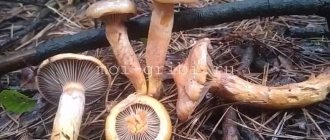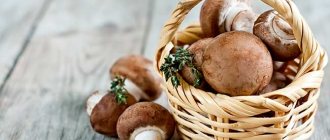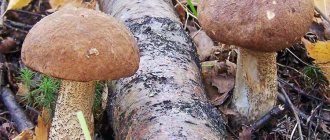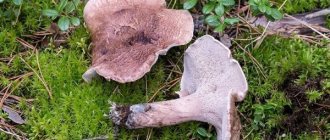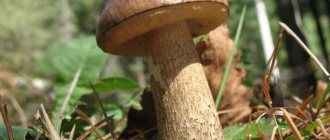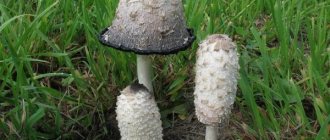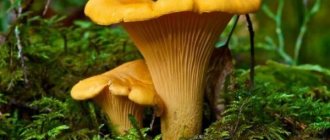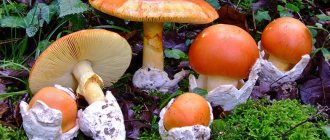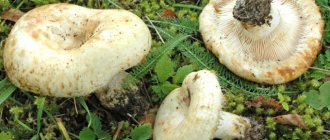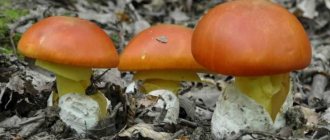Botanical description of blackberry mushrooms
The appearance and taste of blackberries resembles chanterelles, although these mushrooms are not related. Blackberries are difficult to confuse with poisonous or any other representatives of the mushroom kingdom . The main distinguishing feature is the peculiar spines on the underside of the cap. The upper part of the cap can be smooth or pimply.
Like chanterelles, blackberries grow in large colonies and are rarely found affected by pests. There are more than a dozen species of blackberries, many of which are listed in the Red Book.
Growing
This species can be grown in a substrate of sawdust, shavings and tree bark. The substrate is first poured with boiling water, then allowed to cool to room temperature. Squeeze well and place the resulting mixture in a plastic bag, adding mycelium. An incision is made and left in a room with high humidity (70-80%) and a temperature of +20°C. The first harvest will appear on day 30-40.
The substrate can be hemp and bars. They make cuts in them. A saw or other hand tool is suitable for this. Then the mycelium is placed there. The substrate must contain a sufficient amount of moisture, so it is first soaked in water for several days.
Nutritional value and edibility of blackberry mushrooms
Despite the fact that the mushroom has a pleasant smell, not every gourmet will eat it. In terms of taste, it occupies the fourth category. For culinary purposes, only young mushrooms are used , since mature individuals begin to taste bitter. To eliminate the bitter taste, the raw materials should be boiled.
To prepare the dish, usually only the caps of the fruiting body are used. They have a mild sweetish taste and a pleasant nutty aroma. 100 grams of product contains 22 kcal.
French cuisine has many mushroom recipes for main courses, as well as mousses, juliennes, appetizers or side dishes. The powder made from dried specimens is used as a seasoning that adds a piquant taste to dishes.
Features, times and places of fruiting in nature
Fruiting bodies appear in April and until the end of May. Frosts do not in any way affect the growth of the fungus, but after them small dark spots may appear on the forest products.
The common line grows on hills, in well-lit and sun-warmed places, under trees, most often in pine, spruce or birch forests.
Prefers sandy and non-turfed soils and loams for growth. Often found in clearings, clearings, burnt areas, forest edges, and along forest roads.
Does the line form ordinary mycorrhiza?
The ability of the common moth to form mycorrhiza has not been proven.
Photo gallery
Types of blackberry mushrooms
Blackberries originally belonged to the genus Hydnum. Subsequently, scientists, having identified differences between the species, divided the genus into families. Most of them are quite rare, and some of them are listed in the Red Book.
A common feature of all species is the spore-bearing layer (hymenophore), which, instead of tubes and plates located under the cap, has needle-shaped spines. Although they are not sharp, they are quite tough. The fruit body varies in shape from the traditional cap-shaped to coral-shaped and branched.
Blackberry variegated (imbricated)
A conditionally edible mushroom of the genus Sarcodon, which is popularly called kolchak or hawk. The mushroom was nicknamed variegated because of its variegated color and large convex scales on the cap, similar to tiles.
The brown cap grows to a considerable size, reaching a diameter of 20 cm. In the central part it has a funnel-shaped depression. In young individuals, the edge of the cap is rolled up. At the bottom there are brittle spines that go down to a massive stem, which is painted in lighter colors than the cap. The inside is whitish and dense. Prefers to settle in coniferous forests.
Blackberry yellow
The fleshy cap with a diameter of 6 to 12 cm has a flat shape and a concave middle. Depending on the region of growth, the color varies from white to orange. Smooth to the touch with a film that is difficult to peel off. On the lower part, yellow, fragile spines grow, descending to the stem.
Often there are specimens with a leg attached off-center. The pulp has a dense structure and a whitish color. The height of the cylindrical leg is up to 6 cm. It is slightly expanded in the lower part. During growth, parts of the fruiting body can grow together.
Most often it grows in cool places, covered with a dense cover of grass or moss. It can grow singly or in groups, forming long rows or circles. Fruits from mid-summer to late autumn.
Coral blackberry
This unusually shaped mushroom turns the forest into a mysterious and magical one. But since it is listed in the Red Book , the likelihood of meeting it is very low. Usually the fungus settles singly on the stumps and trunks of fallen deciduous trees.
The shape of the branched fruit resembles an underwater coral, reaching 20 centimeters in size. Smooth or curved spines, growing up to 2 cm, are painted white or cream.
The structure of the fruit body is elastic-fibrous , white with a pleasant smell and taste. In mature individuals it becomes harsh.
Comb blackberry
The appearance of the fruiting body resembles a noodle, which gave it synonymous names: bearded mushroom, mushroom noodle and lion's mane. Found on living and dead deciduous wood. The shape of the mushroom is round or irregular, reaching 20 cm. The weight of one body can be 1.5 kg.
When prepared, it resembles seafood. The color is on the spectrum between cream and light beige. The fleshy pulp dries from white to yellowish. In addition to good taste, it has medicinal properties.
In some countries it is very rare, so it is grown artificially on a substrate of sawdust or straw. The product is actively used in the food industry due to its similar taste to shrimp, and also for medical purposes as an immune stimulant.
Contraindications
Previously, strings were considered conditionally edible; now they are classified as inedible mushrooms, because due to non-compliance with processing technology, they can cause severe intoxication and even death.
If during preparation the gyromitrins are not completely destroyed, then even a small dose can provoke serious disorders in the body.
Mushroom pickers suggest that in some specimens the poison content is much higher than in other fruiting bodies, so even double digestion does not make them safe.
There are several contraindications to using stitches:
- children under 12 years of age;
- serious diseases of the cardiovascular system;
- pregnancy;
- breast-feeding;
- individual intolerance.
Medicinal properties of blackberries
Of all the known species of this mushroom, it is the lion's mane that is characterized by the maximum number of beneficial properties. It contains antioxidants, phosphorus, calcium, iron, vegetable proteins, polysaccharides and vitamins.
Eating blackberries has the following effects on the body:
- improves the functioning of the respiratory system;
- contributes to the successful fight against depression and increased excitability;
- has a therapeutic effect on the gastrointestinal tract;
- normalizes emotional state;
- smoothes the symptoms of Alzheimer's and Parkinson's diseases;
- reduces cholesterol levels;
- strengthens the body's defenses;
- normalizes metabolic processes;
- normalizes hematopoietic processes;
- prevents the occurrence of malignant tumors.
The presence of fatty acids, polysaccharides and phenols fight cancer cells similar to chemotherapy. As a result, the tumors resolve or decrease in size. Extracts obtained from the fungus are used in the production of means to combat fungal, viral and bacterial infections. In traditional medicine, ointments for skin diseases are made from it.
Why is scaly tinder fungus dangerous for trees?
The mushroom uses special enzymes, which allows it to turn insoluble compounds into soluble ones. After a certain time, the tree begins to rot, dries out, becomes brittle, and then dies. Elm is able to break a tree to the ground, and then continue to feed on it.
The whole process takes several years; the result of parasitism is not immediately apparent.
Related article - Lacquered tinder fungus (Ganoderma lucidum): a unique medicinal mushroom.
How to prevent tree tinder infestation
The goal of preventive measures is to prevent disease; parasitic fungi settle only on weak specimens.
Prevention of all tree diseases comes down to constant care:
- watering;
- spraying;
- fertilizer.
How to properly cook blackberry mushroom
The shelf life of fresh mushrooms is short, only 2-3 hours. Then the fruits begin to darken. If you need to preserve the crop for a longer period, it should be placed in the refrigerator, following several steps before doing so:
- to get rid of pests, mushrooms need to be soaked in salt water;
- allow the water to drain and remove damaged areas;
- place in a deep container and cover with a paper towel.
The advantage of blackberries over other representatives of the mushroom kingdom is that they do not have milky juice, which gives the fruit an unpleasant bitter taste. In view of this feature, boiling the raw product in lightly salted water has a different meaning.
It is recommended to boil the harvested crop in order to soften the aromatic forest product. After this procedure, it can be fried or stewed. Although boiling is not a strict rule, it improves the taste of the mushroom. To process mushrooms for the winter, it is recommended to pickle, freeze or dry them.
If a lunch of cabbage soup with fish, grouse and gamula seems quite appetizing to you, go to the Russian village and try what our great-great-ancestors ate.
Russian cuisine is a very curious phenomenon. For a long time, gourmets treated it with disdain, which did not at all prevent it from developing, adopting the experience of different national cuisines, and at the same time remaining original.
The main dish on the Russian table was soup, which until the end of the 18th century was called “khlebovo” or “khlebova”. First of all - cabbage soup. They could be "rich" or "empty". Contrary to popular belief, cabbage soup is not always cabbage soup. Their distinctive feature is a sour taste, which can be created by sorrel, apples, and pickled mushrooms. The most complete option is cabbage (or other vegetables), meat (sometimes fish or mushrooms), roots, a spicy dressing (onion, garlic, celery, pepper, bay leaf) and a sour dressing (apples, cabbage pickle, sour cream). Vegetables and sour dressing are mandatory components, including for the simplest cabbage soup.
In addition to cabbage soup, the Russians prepared a great variety of different soups.
Tyurya is a cold soup, the main component of which is bread. It is crumbled, some vegetables are added, and water is added.
Okroshka is also a cold soup, but made with kvass; its main component is vegetables. Meat or fish are sometimes added to them. A real okroshka must combine fresh (boiled potatoes, turnips, carrots, rutabaga, fresh cucumbers) and spicy (green onions, dill, parsley, celery, tarragon) vegetables. Meat should be of different varieties, and even better - from different animals and poultry. The most suitable fish are tench, pike perch, and perch; among sea fish, only cod.
Botvinya is a soup that has practically disappeared from our table. A complete botvinya consists of three parts: the soup itself (cold), boiled fish (not just any fish, but stellate sturgeon, salmon, sturgeon), which is served separately, and finely crushed ice, which is also served separately. Incomplete botvinya (without fish) is a regular green soup. In both cases, the soup part is prepared with kvass with the addition of sorrel, tender leaves of beet tops and other soft or neutral-tasting vegetables.
Chowder is a hot soup made from water and vegetables. One product always predominates in it, and it gives the name to the stew: potato, onion, lentil, etc. These soups are never made from sauerkraut, beets, or beans. Mandatory components are onions and spicy herbs. The vegetables are placed in boiling water and cooked for no more than half an hour, strictly observing the order in which they were added. Chowders are usually not seasoned with anything, at most - only cream or sour cream.
Rassolnik is a soup with a salty and sour cucumber base. The modern rassolnik includes potatoes and rice, while the classic version includes beets. The meat component of this soup is offal or shank.
Solyanka is a thick, spicy soup combining the components of cabbage soup and pickles. It comes in meat, fish and mushroom. Olives, capers, and tomatoes are also added to solyanka. There is little liquid in these soups. The liquid and thick parts are prepared separately.
The Russians borrowed noodle soup from the Tatars, but processed it in their own way. Noodle soup can be chicken, mushroom or milk. It is prepared very simply: separate noodles, separate corresponding broth, and then cook the noodles in this broth.
Ukha is a liquid hot fish dish that is prepared according to strict rules. It should be cooked only in enamel, clay or cast iron dishes. Roach, bream, bleak, ram, herring, mackerel, gudgeon, and gobies are not suitable for fish soup. The best fish soup (the so-called white fish soup) comes from pike perch, whitefish, perch or ruff, because they give a clear broth and have a delicate taste. Black fish soup is prepared from carp, chub, crucian carp, carp, and rudd. In terms of tenderness (“sweetness”), it is inferior to white. There is also the so-called red fish soup - made from sturgeon, beluga, stellate sturgeon, salmon, and nelma. Its second name is amber. There are also regional varieties of fish soup: Volga (sterlet), Pskov, Chud (from smelt), etc. Real fish soup is made from no less than two and no more than four varieties of fish (except for red fish, which is prepared from one type of fish). It is better to combine fatty and lean fish. You need to put very few vegetables. Only onions are placed in the fish soup from live fish, and non-crumbly potatoes, carrots, and onions from fallen fish. Plus spices: herbs, black pepper, bay leaf, etc.
Kalya is a liquid fish dish with the addition of pickles, cucumber brine, lemon and lemon juice (together or separately). In the classic version, kalya was prepared from fatty, mostly red, fish and caviar was added to it. Porridge, which at first was a ritual food, also occupied a fairly large place in the Russian menu. There were porridges - liquid porridges, smears - viscous porridges, and steep - crumbly porridges. Dishes made from cereals and flour were varied with mushrooms, berries, vegetables, fish, and milk. They ate meat quite rarely. And first of all, this is explained by the division of the table into fasting and fasting: there were many more fasting days a year - about two hundred.
Fish dishes occupied a very important place on the Russian table. First of all, it was boiled, steamed, whole (prepared from fillet in a special way), mended (with filling, that is, stuffed), stewed, jellied, baked, salted, dried fish, less often - fried.
Meat dishes did not differ in variety. The meat was cooked in pieces in soups or porridges, and then used as an appetizer or main course. Offal was baked together with cereals in pots. Sometimes they prepared the so-called roast: a whole bird or a large piece of meat was fried in the oven.
One of the most traditional Russian dishes is, perhaps, bread made from yeasted rye dough, which began to be baked in Rus' more than ten centuries ago. Around the same time, they began to make saiki, bagels, pancakes, and pies. In addition to pies, Easter cakes and gingerbread served as real table decorations. This is a separate big topic of conversation; it is enough to just say that there are about twenty varieties of Easter cakes, and gingerbread - twice as many. Gingerbread appeared in Rus' in ancient times, was used as a variant of bread and was quite cheap, but Easter cakes were brought from Byzantium and were always considered products for celebrations and holidays.
And be sure to say a few words about drinks. Almost all Russian drinks are original: kvass, honey, fruit drinks, water, sbitni. Meads were divided into meads (water plus a little honey and hops) and staved meads (strong alcoholic drinks consisting of berry juice, honey and vodka). Voditsa and fruit drinks are drinks based on berry juice, diluted with water and slightly fermented. Kvass is a complex fermented drink based on batter (water, flour, malt), water, yeast, sugar. The flavoring additive determines the name of the kvass: lingonberry, raspberry, raisin, etc. To get sbiten, honey was boiled separately and seasonings (spices and juices) were brewed, and then they were combined and boiled. This is a winter drink and should be drunk hot.
But enough theory. It's time to head to the kitchen.
Triple mushroom soup monastery style
We will need: 1) 1 chicken, 2) 3 fresh sterlet, 3) 1 kg of russula, 4) 10–15 small fresh boletus, 5) 6 potato tubers, 6) salt.
Gut a small lean chicken, rinse it, and boil it whole in 3 liters of salted water. Strain the broth and set the bird aside (you can later use it to prepare a second course or salad). Place the peeled and gutted sterlet into the broth and boil it. Then take out the fish and set it aside (again for the main course, salad or appetizer), strain the broth again. Peel the russula, wash it, chop it coarsely, put it in the broth and boil for 5-7 minutes. Remove the mushrooms with a slotted spoon, transfer to a clay dish, and mix with 2 tbsp. spoons of salt. Let them sit for an hour or two, after which they will form a wonderful appetizer. In the broth we put peeled and coarsely chopped boletus mushrooms, as well as peeled and cut into slices potatoes. Cook for 10–15 minutes. The soup is finally ready.
If you suddenly don’t have sterlet, you can replace it with any white fish.
Simenukha
We will need: 1) 300 g of buckwheat, 2) 100 g of fresh mushrooms, 3) 2 onions, 4) 3-4 eggs, 5) vegetable oil, 6) butter.
Let's cook the buckwheat. Boil the eggs hard and then finely chop them. Chop the onion, brown it in vegetable oil, and then fry the finely chopped mushrooms together with it. Let's combine all this and mix. Season with butter.
Grouse
We will need: 1) 400 g of buckwheat flour, 2) 80 g of melted butter, 3) 1 cup of millet, 4) 1-2 tbsp. spoons of vegetable oil, 5) 50 g of salted lard, 6) 2 onions, 7) 3-4 cloves of garlic, salt.
Mix buckwheat flour and water into a batter, add melted butter and cook over low heat.
Wash the millet very thoroughly in several waters and cook porridge from it. At the end of cooking, season with vegetable oil and salt to taste.
Finely chop the onion and garlic, cut the lard into small cubes.
Now combine the brewed flour and porridge, add onion, garlic and lard, mix thoroughly and eat.
Porridge can be cooked in meat or fish broth.
